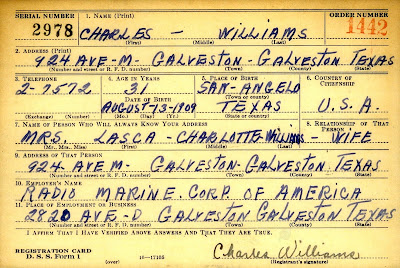“Ah, The Draft!”: World War 2 Draft Cards of American Paperback Writers
“Ah, The Draft!”: World War 2 Draft Cards of American Paperback Writers
The
interest in my first post about historical documents of authors I find in databases was so abysmal, I figured I’d do it again. What was it Albert Einstein
said about doing the same thing over again and expecting a different result? I very well may be mad. This time around, rather than looking for U.S. entry visas
of British writers, I went looking for the World War 2 draft cards of American
paperback writers.
The U.S. draft for World War 2 was instituted in September 1940 – more than a year before America went
to war and (I believe) the first peace time draft in U.S. history – and much like today, all men of a certain age had to register with
the selective service.
Charles Williams
Charles
Williams was long in the tooth when WW2 came to America. He was born in 1909,
which made him 32 years old when the Japanese attacked Pearl Harbor on Dec. 7,
1941, and while Williams registered for the draft he never served in the
military. He had previously been part of the U.S. Merchant Marine from 1929 to 1939 and he worked as a radio technician. According to Ed Lynsky’s excellent article, The High Seas of Charles Williams, “[d]uring the war years 1942-46 [Williams] did duty as
an [civilian] electronics inspector at the Puget Sound Navy Yard in Bremerton,
Washington.” After the war, Williams and his wife, Charlotte, moved to San Francisco where he worked for MacKay Radio Co. until the success of his first novel, Hill Girl (1951), allowed him to pursue writing fulltime. Charlotte died of cancer in 1972, and Williams killed himself on April 9, 1975, in his Van Nuys, California apartment.
The draft card: Notice Williams
had no middle name, he lived in Galveston, Texas at the time, and he worked for
Radio Marine Corp. of America. If only that telephone number still worked.
Jim Thompson
The
bleakest of the hardboiled writers, Jim Thompson, was no youngster when the law required him to register for the draft. He was born Sep. 27, 1906, and like Charles
Williams he never served in the military during the war. He did, however, work at an aircraft manufacturing plant at the war’s beginning. His first novel, Now and on Earth was published in 1942. Thompson drank heavily all his life and alcoholism was a prevalent, if subtle, theme in his fiction. He died April 7, 1977, in Los Angeles, California.
The draft card: Notice
Thompson’s address is crossed out and a note – “Gen. Del. Las Angeles Calif.” –
is written at the top. Los Angeles is a misspelled, “Las Angeles”. The written address, which is crossed out, is in Oklahoma and it matches the address given for his wife (listed as next of kin).
Edward S. Aarons
Edward
S. Aarons was born Sep. 11, 1916. He was 25 years old when America entered WW2. Aarons enlisted in the U.S. Coast Guard (perhaps in early-1942) and served through, from the notation at the top of the draft card, “(Hon. release - 11/9/44)”, 1944. When Aarons registered for the draft he lived with his father, Jacob, in
Philadelphia, and identified his employer as “In business for himself”. Aarons had three published novels in 1938 and 1939, all from Phoenix Press and as by Edward Ronns, but during the war years he was silent. His byline didn’t appear again until 1947 when McKay published, No Place to Live and Terror in the Town, both as by Edward Ronns. Aarons died June 16, 1975.
Charles Willeford
There has
been much written about Charles Willeford’s military service. He served with Company
C, 11th Tank Battalion, 10th Armored Division, in Europe and fought in the Battle
of the Bulge and earned several medals for valor, including a Silver Star. When
Willeford registered for the draft he lived with his father-in-law, Charles F. Fridley,
in Los Angeles, California. Under employer’s name it identifies Willeford
as a “discharged veteran, not yet employed reenlisted Reg. Army”. According
to the Department of Veterans Affairs’ BIRLS death file, Willeford served in
the U.S. Army from Sep. 7, 1935, to Dec. 2, 1938, and reenlisted Mar. 14, 1939.
Willeford’s first published work, a book of poetry titled Proletarian Laughter, appeared in 1948 and his first crime novel, High Priest of California, arrived in 1953. He was born either January 2, 1917 or 1919, (see The draft card section below for more details), and died from congestive heart failure in Miami, Florida on March 27, 1988.
The draft card: Notice this one is typed, and very neatly. I’m also intrigued about his listing his father-in-law as his contact rather than his wife. There is a discrepancy for Willeford’s birth year. The birth year listed in his online “biographies” and in his Contemporary Authors entry is 1919, but on the draft card, BIRLS death index, and Social Security death index, his birth year is listed as 1917. It’s possible Willeford lied about his age when he enlisted in 1935 (he would have been 16), or perhaps his birth year was actually 1917?
Copyright © 2022 by Ben Boulden / All Rights Reserved






Comments
Post a Comment